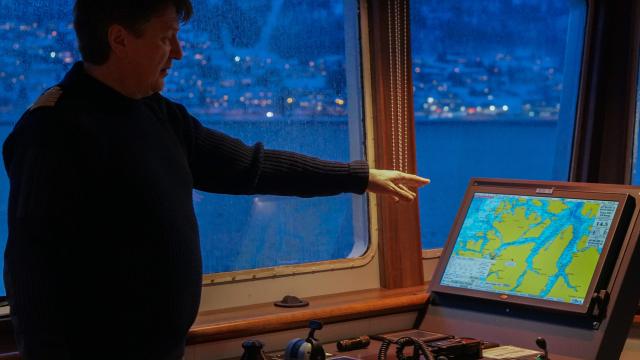You can tell the Norwegian research vessel Johan Hjort is made for the Arctic because it holds a tanning bed inside.
“Quite a few have these in fact, especially those vessels working over the high north during the winter when there is no sun at all,” said the boat’s captain, Hallgeir Johansen. A few passengers like to get brown for the looks of it, but the bed is mostly there for mental health, Johansen said. “Some days you miss your family, there are long days, maybe it’s a small world on board. There are ups and downs of course,” he told me, his voice swimming with its own ups and downs, in the subtle waves of Norwegian-accented English.
The Johan Hjort is used by scientists from the Norwegian Institute of Marine Research, an arm of the country’s larger Ministry of Fisheries and Coastal Affairs, to conduct analyses of the marine ecosystem in Norway’s waters. The morning I climbed inside the Johan Hjort in late January was the boat’s last day in the Arctic seaport of Tromsø. It was soon set to depart for the Barents Sea, where it was to meet a Russian ship to jointly examine the stocks of cod and haddock in the area. The data collected would be used to inform the national fishing quotas, limits that change each year based on analyses like theirs, and prevent overfishing of the wild stock.
The crew makes it all possible. Steering the boat from the bridge is a one man operation, but three sailors rotate in and out of the job, Johansen told me, as he demonstrated how the screens displayed ocean details that the scientists would later use in their calculations. The Chief Engineer and First Engineer mostly man the engine room but double as plumbers and electricians when needed, and six men stay on deck. In the galley, three take care of food preparations, “like a small hotel,” the captain said. He introduced me to the chef in charge of culinary affairs, who laughed when I asked him whether he ever got tired of cooking cod. “More than just fish,” he responded with a shy grin. It was his first day on the job.
It was hardly the captain’s. Johansen has been at sea for 25 years, in all kinds of boats: commercial shipping, deep sea, research, off shore, icebreakers, and fishing vessels large and small. When I asked his favourite? “Everything has its charm,” he answered, ever the diplomat. His worst fear is not the tedium of trips, but a fire on board. “You can’t run anywhere. That makes it more scary,” he told me. “But we’re well trained, so we’d be able to cope with it.”
The scientists are trained for their jobs on the ship, too. Downstairs, Johansen led me into the area where the water sampling machine, called a CTD rosette, is kept. CTD stands for Conductivity, Temperature and Depth—exactly what the bottles attached to the device measure when the researchers release the device into the ocean. With the dark, cylindrical bottles pinned all around its frame, the machine looks less like a rose and more like a human-sized bundle of dynamite.
Following the captain, I ducked my head into the room next door. It was empty, save for silver counters that were topped with folds of yellowed mesh. The scientists cast the mesh into the water to catch plankton, the small, drifting organisms that form the bottom of the marine food chain. The room transforms into one of the boat’s most active areas when the vessel is in motion, Johansen told me. The fish are gathered by massive, green nets the Johan Hjort drags behind it as it moves forward. Then, alive and squirming, the fish blast into the room through a silver chute in the back. Scientists process and weigh them immediately, then bag them for future examination in the boat’s inner laboratories.
Next on the tour was the storage space (spools of green netting as tall as the roof), the engine room (two engines, one desalination machine), and the entertainment lounge (shelves of books, a small theatre complete with couches and a flat-screen TV). Our last stop was the gym and sauna area, in front of the tanning booth. The space had its own name: “Klubb Midnattsol Solarium,” read the laminated sign on the door to the sauna. In English, that would be “Midnight Sun Solarium Club,” in reference to the never-setting sun of Arctic summers.
As we climbed back upstairs to end the tour, the captain told me about some of his past voyages. He made his first at age 18, aboard a shrimper. Once, with three and half tonnes of lemons in tow, Johansen had sailed along the river that marks the border between Argentina and Uruguay. And he used to make trips back and forth between the Arctic and North America, calling into the ports of the Faroe Islands, Iceland, Massachusetts, and Canada. When he remembered loading up with potatoes in Prince Edward’s Island, a smile broke wide across his face.
In the bridge, the captain’s first mate made us coffee, and Johansen took a more somber tone. “Why do we send the fish from Europe to China to be processed, and back again?” he asked. “Things like that make a huge footprint.” Buy locally when you can, but don’t overly criticise individuals when government policies and corporate deals usually have far more of an impact on the environment, he recommended.
I thanked the men for their hospitality, then lowered myself down to the icy floor of the Tromsø port. The sun had risen in my absence. Before it would sink below the horizon again, the Johan Hjort would be gone.
Chiara Eisner is a multimedia investigative journalist whose work has focused on international politics, criminal justice, and science and technology. More of her reporting can be found here. Send her a tip: eisnerchiara@gmail.com
